To spread fertiliser across the vineyard in a speedy way the broadcast applicator is best, normally requiring a pass up every third or fourth row, operating at a speed of four to six kph.
While the spread on the ground will be even, growers often find that this method feeds everything, including the grass and weeds in the alleyways. To avoid this and to make the application more accurate, some spreaders can be fitted with an optional side ejection system. This will effectively place fertiliser along the vines’ feet in the root zone and is the preferred method for growers who have chosen to spread a more expensive fertiliser material.
“Those looking to make the fertiliser application even more precise, can opt for a GPS led variable rate spreader,” said David Sayell of Vitifruit Equipment. “This method is extremely efficient and can help to significantly save money, as fertiliser is not applied to soil that is already in good order. With the help of soil analysis and software mapping from your agronomist, the spreader will automatically vary its output. Typically, growers find that soil at the top of a hill needs feeding, while at the bottom it does not.”
Vineyard managers looking to apply compost can make use of spreaders which have been designed to put the material along the feet of the vines or broadcast it only in the alleyway. David advises that if the site has a particularly bad weed problem, it is better to apply in the alley and let the worms incorporate the material. Compost spread under the vines can create ideal conditions for weed growth and this will cause further challenges.
For chalk dominant soils, a spiked wheel liquid chelate (iron) injector can also be used to successfully distribute the feed material in the soil as close to the roots as possible for a faster uptake. If applied on the surface only, it may take two or three years for the iron to penetrate down to the roots.




